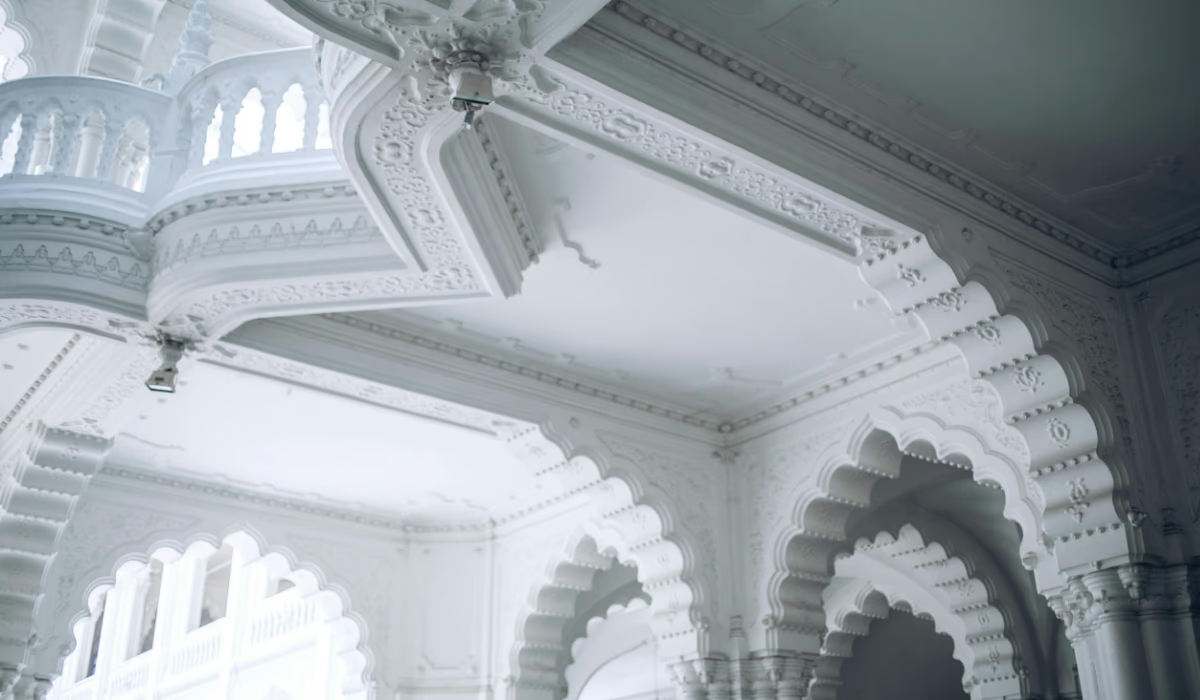Baroque interior design is a richly decorative style originating in 17th-century Europe. It is known for its lavish ornamentation, dramatic contrasts, and grandeur. Interiors in the Baroque period featured sculpted wood moldings, gilded surfaces, opulent furniture, and elaborate ceiling art that conveyed power and luxury.
The style was tightly linked with architecture and the arts, used in palaces, churches, and grand residences to display wealth and prestige. Over time, Baroque has influenced many other styles and continues to appear in modern interior decor.
History and Evolution of Baroque Style Interiors
The Baroque era began in Italy around 1600 and later spread to France and other parts of Europe. Monarchs and religious institutions used it to impress — think vast halls, ceilings painted with dramatic scenes, and ornate details everywhere.
In France, during the reign of Louis XIV, Baroque merged with Classicism, creating interiors where symmetry, rituals, and formal layouts played key roles. Palaces like Versailles are prime examples.
The style waned in the mid-18th century as tastes shifted, but revived periodically. Modern reinterpretations adopt select Baroque features, refining them to suit contemporary homes while preserving a sense of drama and opulence.
Key Characteristics of Baroque Interior Design Style
Ornate Decoration and Dramatic Details
Baroque interiors are full of ornamentation: carvings, gilded moldings, sculpted panels, and detailed ceiling artwork are standard. Furniture and décor pieces are often bold, grand, and meant to draw the eye.
Use of Luxurious Materials and Textures
Rich materials like marble, velvet, brocade, lacquered wood, porcelain, and gold or silver finishes are common. Surfaces shine and textures are layered. The interplay of light on these materials adds to the opulent feel.
Emphasis on Symmetry and Grandeur
Symmetry—balancing architectural and furniture elements—is central. Rooms are often arranged formally: matching pieces on each side, grand focal points, mirror work, and rich, deep color palettes accentuated with metallics.
Curved Forms and Movement
Curved or flowing lines—scrolls, volutes, elegant foliage motifs—appear in furniture, moldings, and decorative flourishes. This creates visual movement and a sense of drama, avoiding harsh straight lines.
Modern Baroque Interior Design: How It’s Adapted Today
Modern baroque interior design takes the dramatic and ornate base of Baroque and refines it for present-day living. Instead of full excess, the approach is more selective and harmonious.
In modern spaces, one or two statement elements—such as a gilded mirror, a chandelier, or an ornately framed painting—can bring the style alive without overwhelming the room. Neutral walls or simpler furniture help ground these features.
Color palettes are softer: creams, muted golds, warm grays, gentle metallics. Fabrics like velvet or brocade are used in accents rather than across every piece. The idea is contrast—luxury touches set against clean or minimalist backdrops.
How to Incorporate Baroque Interiors in Your Home
- Choose a signature piece first. A grand mirror, chandelier, or an ornate frame can serve as the focal point.
- Balance ornate with simple. Pair a sculpted console table with unadorned seating, or use richly textured curtains alongside pared-back walls.
- Use lighting to highlight decorative elements. Spotlights, wall sconces, or a chandelier with warm light can emphasize gilded surfaces, moldings, or carved woodwork.
- Select materials and fabrics wisely. Incorporate rich textures in small doses—velvet upholstery, decorative pillows, or brocade accents—to add elegance without overwhelming.
Conclusion
Baroque interior design is about grandeur, emotion, and artistic expression. Its history is steeped in opulence and dramatic detail. Modern baroque brings that richness into contemporary homes in a refined way, fusing elegance with thoughtful restraint.
FAQs
What defines baroque interior design as a style?
It is defined by ornate decoration, dramatic and sculptural forms, rich materials, grand scale, and a strong sense of symmetry and luxury.
How can modern baroque interior design be applied without overwhelming a space?
By using statement pieces sparingly, balancing ornate details with clean lines, and choosing a softer color palette to allow dramatic elements to shine.
What is the difference between baroque style and rococo?
Rococo is a lighter, more whimsical evolution of Baroque, with more playful curves, lighter color schemes, and less formality and grandeur.
Where in the home does baroque design work best?
Living rooms, dining rooms, entrance halls, or any space where one wants to make a strong visual impact. Accent walls or focal points benefit most from this style.







